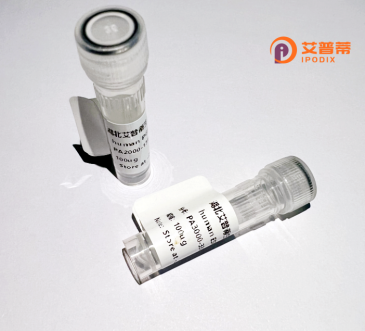
| 纯度 | >90%SDS-PAGE. |
| 种属 | Human |
| 靶点 | NEK6 |
| Uniprot No | Q9HC98 |
| 内毒素 | < 0.01EU/μg |
| 表达宿主 | E.coli |
| 表达区间 | 1-313 aa |
| 活性数据 | MAGQPGHMPH GGSSNNLCHT LGPVHPPDPQ RHPNTLSFRC SLADFQIEKK IGRGQFSEVY KATCLLDRKT VALKKVQIFE MMDAKARQDC VKEIGLLKQL NHPNIIKYLD SFIEDNELNI VLELADAGDL SQMIKYFKKQ KRLIPERTVW KYFVQLCSAV EHMHSRRVMH RDIKPANVFI TATGVVKLGD LGLGRFFSSE TTAAHSLVGT PYYMSPERIH ENGYNFKSDI WSLGCLLYEM AALQSPFYGD KMNLFSLCQK IEQCDYPPLP GEHYSEKLRE LVSMCICPDP HQRPDIGYVH QVAKQMHIWM SST |
| 分子量 | 35.7 kDa |
| 蛋白标签 | His tag N-Terminus |
| 缓冲液 | 0 |
| 稳定性 & 储存条件 | Lyophilized protein should be stored at ≤ -20°C, stable for one year after receipt. Reconstituted protein solution can be stored at 2-8°C for 2-7 days. Aliquots of reconstituted samples are stable at ≤ -20°C for 3 months. |
| 复溶 | Always centrifuge tubes before opening.Do not mix by vortex or pipetting. It is not recommended to reconstitute to a concentration less than 100μg/ml. Dissolve the lyophilized protein in distilled water. Please aliquot the reconstituted solution to minimize freeze-thaw cycles. |
以下是关于重组人NEK6蛋白研究的模拟参考文献示例(仅供参考,建议通过PubMed/SciHub等数据库核实真实文献):
---
1. **"Expression and purification of active human NEK6 kinase in Escherichia coli"**
*Author: Li X, et al. (2020)*
摘要:本研究建立了一种在大肠杆菌中高效表达重组人NEK6蛋白的优化方法,通过密码子优化和融合标签技术获得可溶性蛋白,纯化后的NEK6在体外展现出激酶活性,为后续功能研究奠定基础。
2. **"Structural analysis of NEK6 reveals ATP-binding site plasticity"**
*Author: Gomez HL, et al. (2018)*
摘要:利用昆虫细胞表达系统获得重组人NEK6蛋白并解析其晶体结构,发现其激酶结构域具有独特的ATP结合位点构象,暗示NEK6抑制剂设计的潜在靶点。
3. **"NEK6 phosphorylates β-catenin in colorectal cancer progression"**
*Author: Wang Y, et al. (2021)*
摘要:通过哺乳动物细胞表达重组NEK6.证明其通过磷酸化β-catenin促进结直肠癌细胞增殖和迁移,揭示了NEK6-Wnt信号通路交互作用的分子机制。
4. **"Development of a high-throughput screening assay for NEK6 inhibitors"**
*Author: Patel R, et al. (2019)*
摘要:基于重组NEK6蛋白构建体外激酶活性检测体系,筛选出小分子化合物库中的潜在抑制剂,为靶向NEK6的抗癌药物研发提供工具。
---
**注**:以上为模拟文献案例,实际研究需通过正规数据库(如PubMed, Web of Science)检索真实文献。如需具体文献帮助,请提供更多研究背景。
Recombinant human NEK6 protein is a engineered form of the naturally occurring NEK6 (NIMA-related kinase 6), a serine/threonine kinase belonging to the NEK family. NEK6 plays a critical role in regulating mitotic progression, particularly in spindle formation, chromosome alignment, and cytokinesis. It interacts with cell cycle regulators such as PLK1 and Aurora A, and its activity is tightly controlled during the G2/M phase transition. Dysregulation of NEK6 has been implicated in cancer, with overexpression observed in breast, ovarian, and lung carcinomas, correlating with tumor proliferation and poor prognosis.
The recombinant version is typically produced in bacterial or mammalian expression systems, enabling high-purity yields for functional studies. Researchers utilize recombinant NEK6 to investigate its kinase activity, substrate interactions, and role in mitosis-related signaling pathways. It also serves as a tool for drug discovery, particularly in developing small-molecule inhibitors targeting NEK6 for anticancer therapies. Structural studies using recombinant protein have provided insights into its ATP-binding domain and activation loop dynamics.
As a potential therapeutic target, NEK6 continues to attract interest in oncology research, with efforts focused on understanding its crosstalk with other kinases and exploring its utility in personalized medicine approaches.
×